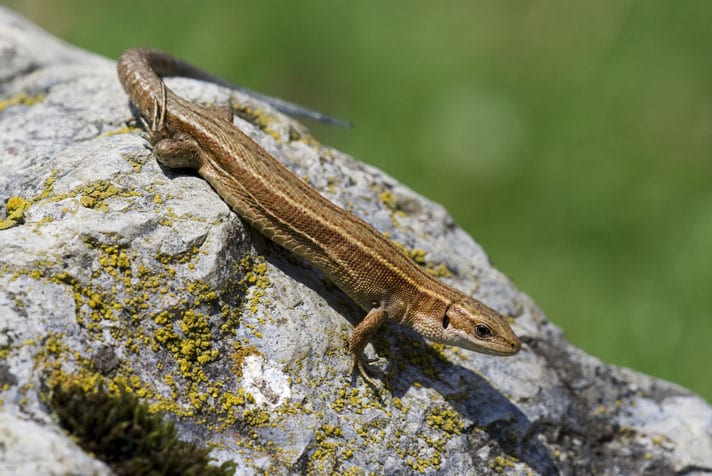Reptilekeeping has become more popular in Ireland over the last 10 years.
Could Saint Patrick’s supernatural ability to famously rid Ireland of all snakes upon his arrival in the fifth century be the reason none occur there? Whether or not the apparently ophidiophobic saint really had anything to do with it, it is true there are no indigenous Irish snake species and, in fact, only one reptile resides on Irish soil: the common lizard (Zootoca [formerly Lacerta] vivipara, also known as the viviparous lizard).
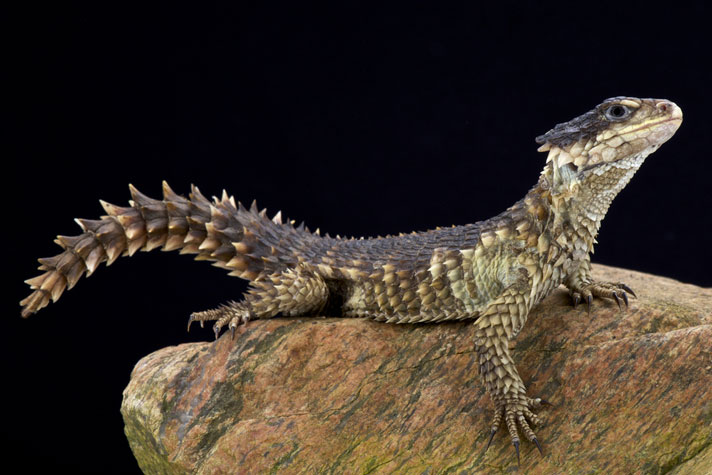
reptiles4all/shutterstock
Reptilekeeping has become more popular in Ireland over the last 10 years.
In my 33 years of living in the stunningly beautiful countryside of Northern Ireland, I have never seen a common lizard. Nor have I seen any of the leatherback sea turtles (Dermochelys coriacea) that are sometimes spotted in the waters off the coast. Yet, despite the rarity of wild reptiles in the country, reptile ownership, and enthusiasm for the animals in general, is a hobby that been trending upward here in the past decade. So I decided to take a look at some of the current reptile-related goings-on across Ireland, to determine if my homeland really is a herpetological desert or if some hidden herping pots o’ gold could be discovered.
An Uncommon Sighting Of the Common Lizard (Zootoca [formerly Lacerta] vivipara)
In August 2016, over the course of three hours, more than 40 common lizards, including 16 newborns, were observed basking in the summer sunshine at Slievenacloy Nature Reserve in the Belfast Hills by local volunteer Philip McErlean.
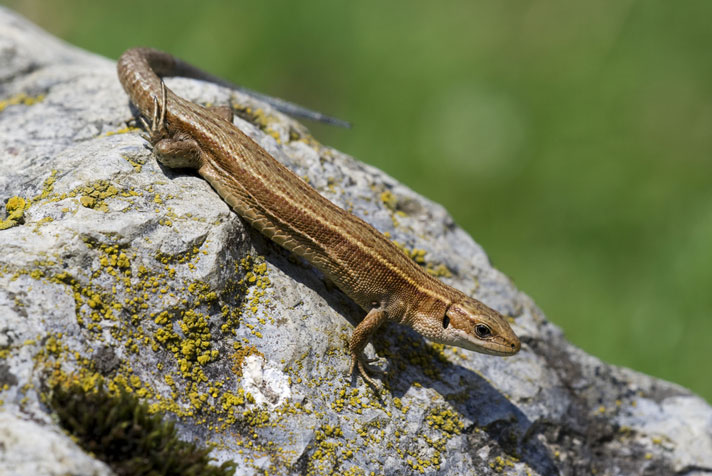
Horia Bogdan/Shutterstock
Slievenacloy Nature Reserve provides an ideal home for these secretive creatures, the common lizard (Zootoca vivipara).
Retirement led Philip, who’s from Belfast, to take up surveying the lizards across Northern Ireland in 2011. Prior to this, like most people in Ireland, he was unaware of their existence, even though Northern Ireland — made up of the six counties of Antrim, Down, Tyrone, Fermanagh, Londonderry and Armagh — had actually designated the common lizard, as the Province’s only native reptile, an officially protected species (it is also protected in the Republic of Ireland, comprised of all the other counties on the island).
One of the ways this solo native reptile has survived and settled in Ireland is by adaptation, surviving the cooler Irish climate by hatching its eggs internally and giving birth to live young in the later summer months. During winter, the lizard hibernates. McErlean explained, “During the summer there is a great boost to numbers, with lots of little, dark-colored, baby lizards making an appearance, though last year, the poor spring and summer weather contributed to a huge drop in the birth rate.”
Slievenacloy Nature Reserve provides an ideal home for these secretive creatures – rough field margins and open sunny banks protected from grazing, and unimproved grassland providing a plentiful supply of insects. Common lizards, therefore, are at least one wild reptile you can go herping for in Ireland. However, they’re not the only reptiles to be found.
Ireland’s National Reptile Zoo
James Hennessy, from Kilkenny in the Republic of Ireland, owns and operates Ireland’s National Reptile Zoo, the only establishment of its kind across the entire island. It opened to the public 10 years ago and has been thriving year-by-year since. “I was bringing a lot of my collections home with me, and opening [the zoo] became a bit of a necessity,” he explained, “after travelling around South America, Africa and Asia.
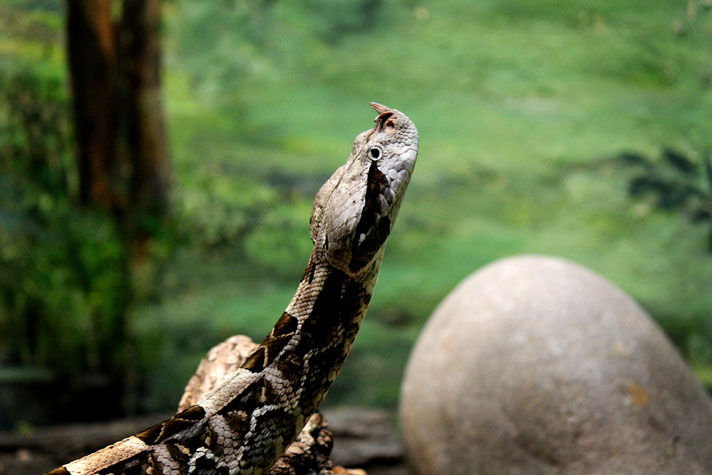
Caspian Summer/Shutterstock
The National Reptile Zoo is home to a six foot Gaboon viper, like this one.
“A certain section of the reptile industry has grown, and the advent of the internet has made more stuff available to people in Ireland,” Hennessy continues. “[The reptile-keeping hobby] is now more accessible here. Impulse buys have increased, but for those with a major passion, that has always been there.” He explains that in the Republic of Ireland, there are no licensing laws governing the ownership of reptiles, whereas in Northern Ireland (which is a part of the UK), there is.
“We’ve got two American alligators that are 12 feet long. One of them is named Battle, and he was one of the last alligators to come to Europe from Florida before new laws preventing this went into effect about 20 years ago. He came to us from a zoo that closed down in England. They are breeding quite well in Europe, and there are alligators available in the UK and within Europe, though they are not being bred in Ireland.”
When asked about visitors’ reactions to the reptiles at the National Reptile Zoo, Hennessy states, “For the Irish public who come here, they are often fearful when they come in and are quite shocked to see all these rare reptiles, but then it’s very educational. The way we present the animals, visitors come to realize reptiles are not the evil beings they may have thought they were before they came in! Kids from kindergarten to college come and visit us. We are very family oriented, and during the summer, the National Reptile Zoo can have up to 25,000 or more visitors.
“Visitors are quite taken with our rhino iguana, a large and impressive animal named Jarred, as he tends to come up to the glass to head-bob at them. They also find our venomous species fascinating. Our monocled cobras are always a favorite, especially during feeding time. Our 6-foot Gaboon viper also tends to amaze people. Her sheer girth tends to leave people in awe.”
According to Hennessey, the National Reptile Zoo houses 170 individual animals comprising 60 species. They include saltwater crocodiles, Fiji iguanas, a Chinese alligator, roughneck monitors, crocodile monitors, a pancake tortoise, casque-headed iguanas, blue-tongued skinks, caiman lizards, scheltopusiks, green anacondas and alligator snapping turtles to name just a few.
Hennessy described what visitors could expect. “The zoo is self guided for the average visitor. There are 50 exhibits with placards detailing each species inside, their habitat, conservation status, etc. We also incorporate as much interaction as we can in order to gain the public’s empathy for reptiles, to further our conservation goals. As such we have Animal Encounter Sessions every hour, using two different animals each time, during which we let visitors get closer and even hold certain species. We also do our health checks and take morphometric data during some of these sessions, showing the public the kind of work that’s carried out here.
“We also have an Interactive Tropical Dome containing green iguanas, red- and yellow-footed tortoises and a few other species, where visitors are taken inside to experience the true feel of where these animals live. All the animals inside it are free roaming, and visitors can come into contact with them.”
Hennessy’s obvious passion for his work with reptiles and activism shines through. “I don’t see it as a job, really. I see it as a vocation. I and the staff (five in the winter, up to 12 in the summer) almost see the animals as family. We enjoy seeing Irish people’s attitude change after they’ve been through our doors. They go from fearing the reptiles to being in awe of them.”
Meanwhile, in County Antrim
On a quiet Saturday afternoon, together with my two nieces and nephew, aged 9, 4 and 7 respectively, I went on an Irish type of herping adventure and viewed an exciting gathering of rare reptiles (for this part of the world) in a small, independently owned business in Clough Mills, County Antrim. Within no time, my youngest niece and nephew, Anna and Sam, were enjoying touching a Carolina corn snake (Pantherophis guttatus) and fascinated by the reptiles before them.
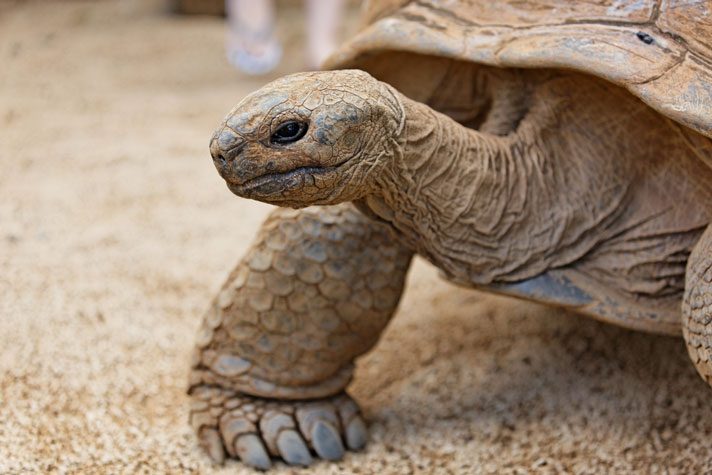
Daniel Wilson/Shutterstock
There is only one Aldabra tortoise in Ireland.
Richard Potter, from Ballymena, hosts a fabulous array of reptiles at Jungle Pets, which is home to many reptiles. This includes Sammy-Jo, who is, “The only Aldabra tortoise in the whole of Ireland,” Potter proudly tells me. Jungle Pets is also home to other creatures I had personally never seen before in real life, including two spectacled caiman (Caiman crocodilus).
From the Seychelles, now residing in County Antrim via a 400-mile-trip to London, Potter told me a bit more about Sammy-Jo. “Sammy-Jo’s from the Seychelles,” he said, “but I picked her up for a sum of £1,500 (around $2,000) in London and took her home in my van (including on the ferry over the Irish Sea). I wouldn’t part with her for less than £4,500. She’s beautiful and only 4 years old.”
Potter explained his avid, rare-for-an-Irishman interest. “For the last 20 years or so, I’ve developed my passion for reptiles. I also saw a gap in the market. There was only one other reptile store in the whole of Northern Ireland, so I decided to go for it [and open Jungle Pets]. I tried to do a different interpretation, with modern procurements and spacious habitats, bringing it up to date with the UK market.”
He explained that in the early days, before licensing laws were introduced in Northern Ireland in 2006, he even kept cobras. “But not now!” Potter says. “Back then, there was no licensing law, so I became very adept at keeping them — cobras and rattlesnakes, and I had anacondas, too. There’s now a UK law — the Dangerous Wild Animal Act – and so there are animals we can sell, and certain types we can only sell to people with licenses. The rest of the UK — Wales, Scotland, England — I would say is quite relaxed about that law, but over here [in Northern Ireland] they are quite stringent about it. So because of that stretch of water [the Irish Sea] between us and the mainland, people find it hard to get certain kinds of species. That’s where we come in. We are able to source those.” He tries to get over to one of the big reptile shows in Europe, either Germany or the Netherlands, once a year.
“We try to replicate as close to the reptiles’ habitat as we possibly can,” Potter says about maintaining the animals at Jungle Pets, “by studying, talking to various people, and working very hard. We’ve got contacts in certain zoos, so we talk with them. We also supply them with certain animals, and over the years, that’s helped us to put together the best possible habitat for these reptiles to thrive in captivity in Northern Ireland, and every bit as much as they would in their own original environment.” A carpenter by trade, Potter built the reptile enclosures at Jungle Pets himself. “My favorite reptiles are the caimans, and I like making their habitats. Feeding time’s always good fun!”
Potter has his share of quirky reptile tales “When we were located in Ballymena (one of the larger cities in Northern Ireland), a rhino iguana named Mr. Kipling escaped through the side gate. He accessed an entry onto a main street, and sure enough, he drew a crowd. There were about 20 or 30 people out looking at him, in the main shopping area of the town, while he calmly basked in the sunshine!
“Another time, a guy came into the store with a fish and chip shop box, laughing, and I thought he was bringing me chips. But he said to me, ‘There’s a snake in this box.’ He told me he was going to the chippy, and there was a woman outside screaming her head off. It was due to a corn snake that got out of the store, and we didn’t even know it was missing! So he brought it back up to us in this fish and chip box. I was disappointed I wasn’t getting my cod and chips!”
Potter also presents reptile demonstrations at schools and local events, educating and inspiring mostly the younger generation. “I’ve got a wee son, Jack, who’s big into his frogs, so, hopefully, this will catch on with him, too. Kids love the reptiles, and it’s often their first time seeing any of these creatures in real life. So it’s great for them to get a feel of a real snake, or even just to hold a strange-looking lizard.”
Having never seen or touched a snake before, my youngest niece and nephew, Anna (4) and Sam (7), both loved the opportunity to engage with the many snakes and reptiles at Jungle Pets that they would otherwise never get a chance to see or touch. It was a fun first kind of herping adventure together with these kids, and hopefully not the last! Where else would an Irish child get to have up-close encounters with such creatures as a royal python (Python regius, otherwise known as the ball python), the mildly venomous leaf-nosed snake (Langaha madagascariensis), or a even a red-eyed treefrog (Agalychnis callidryas) — never mind a spectacled caiman or Yemen, or veiled, chameleon (Chamaeleo calyptratus).
We were also treated to many other well-kept and seemingly very content herps, including the warty chameleon (Furcifer verrucosus), mountain horned dragon (Ancanthosaura sp.), Malagasy rainbow frog (Scaphiophryne gottlebei), sungazer lizards (Smaug [Cordylus] giganteus), a banana morph of the Mexican spiny-tailed iguana (Ctenosaura pectinata) and various tortoises such as the Hermann’s (Testudo hermanni) and Horsfield’s (Testudo horsefieldii, also known as the Russian) tortoises.
In speaking about the specific differences between looking after reptiles in Ireland and the U.S., Potter said, “It’s more expensive to keep reptiles here than in America. Over here, we have to spend quite a lot on heating and artificial lighting. A bit like everyone else here in Ireland, reptiles are affected by the weather!” he joked. “As long as they’re kept warm, at the right regulated temperatures, then they’re happy reptiles.”
More Reptiles in Ireland
In northwestern Ireland, in the beautiful rural town of Letterkenny, County Donegal, is the Tropical World complex, which features a sort of mini zoo that includes reptiles. Tanya Jacobs, who’s in charge of maintaining the reptiles, states, “We’ve had these reptiles here since we opened five years ago. Everyone is very fond of the sulcata tortoises.”
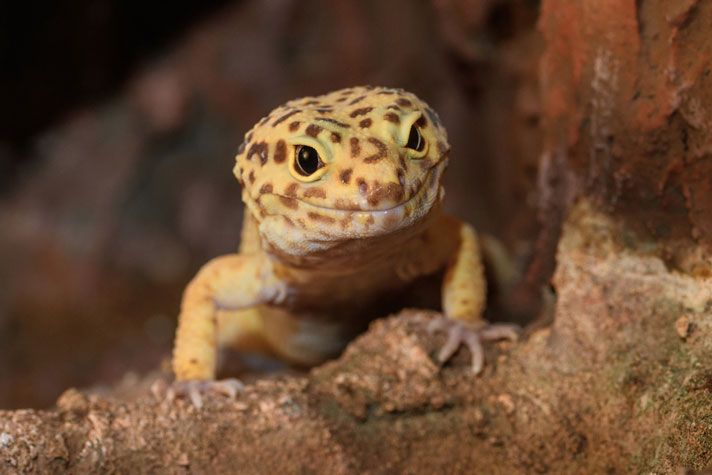
Csakanyl/Shutterstock
Leopard geckos are popular in Ireland.
Tropical World houses a variety of other cold-blooded creatures, including but not limited to leopard geckos (Eublepharis macularius), leopard tortoises (Stigmochelys pardalis), Indian star tortoises (Geochelone elegans), red-footed tortoises (Chelonoidis carbonaria), and some North American yellow-bellied terrapins (Trachemys scripta scripta).
“We’ve had a very busy summer, with probably over 20,000 visitors in through the doors,” said Jacobs. The summer was rainy, which seems to result in more visitors. “Of course, the reptiles are like everyone else in Ireland – they are subject to the weather!” Jacobs joked, echoing Potter’s previous comments. “We keep the heated lamps on and keep the temperature at a regulated 28 degrees Celsius (82 degrees Fahrenheit) for all the reptiles. In the winter, we close down from October until Easter, and we go to great lengths to insulate the whole roof and walls to keep the reptiles warm and well protected during the cold and wind of the winter months.”
And what of the pet reptile trade in Ireland? Pets at Home is the largest pet store chain in the UK, and I visited the Derry/Londonderry shop in Northern Ireland, where a small reptile section is maintained. I was told it was the last remaining such display to be found in any of the chain’s Northern Ireland stores. “We don’t sell many reptiles here,” an employee told me, “but a regular small number, maybe four snakes and two bearded dragons a month. It’s a pretty specialized market here.”
Meanwhile, in Belfast, you can find City Reptiles, owned by Wayne Hall and one of the longest-established reptile stores in all of Ireland, having been in business for 27 years. Hall’s son, Nathanial, told me, “We have pythons, tortoises, corn snakes, bearded dragons and various other things. We used to get a lot more variety, but those are the main things now.”
He added, “The more people hear about reptiles in Belfast over the years, the more people have gotten them as pets, especially the bearded dragons. Bearded dragons are very popular here in Belfast.”
While the Irish may not have yet attained the same level of pet reptile keeping as U.S. hobbyists, or even had the opportunities to be exposed to them as regularly, as you can see, some reptile experiences can be found. So if you’re thinking of a trip to Ireland, a stunning place where Americans are nearly always warmly welcomed, there are evidently more beautiful reptiles to be seen and appreciated than one might at first imagine — even if St. Patrick did rid the land of snakes all those years ago!
Leanne Dunlop is a freelance journalist and writer based in County Antrim, Northern Ireland. Her science degree background in Psychology from Queen’s University Belfast includes minors in animal behavior.

